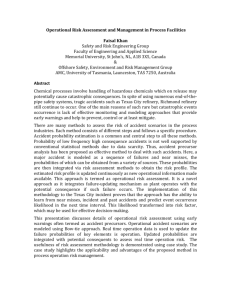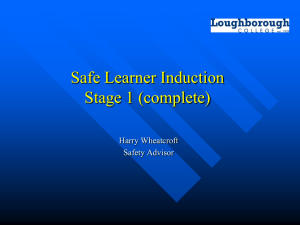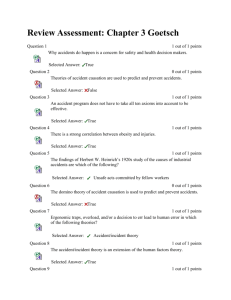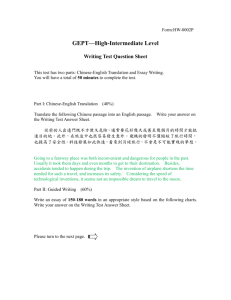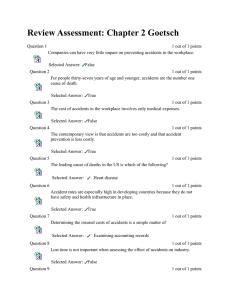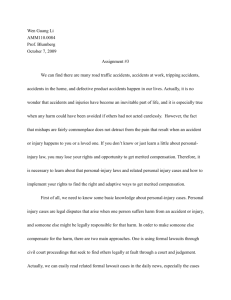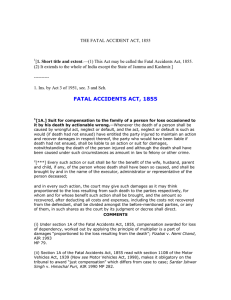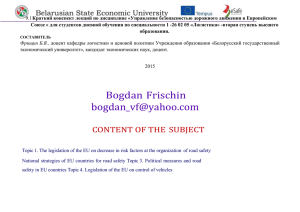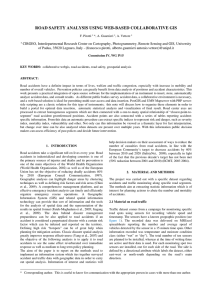Topic One - An introduction to Health & Safety in Industry
advertisement
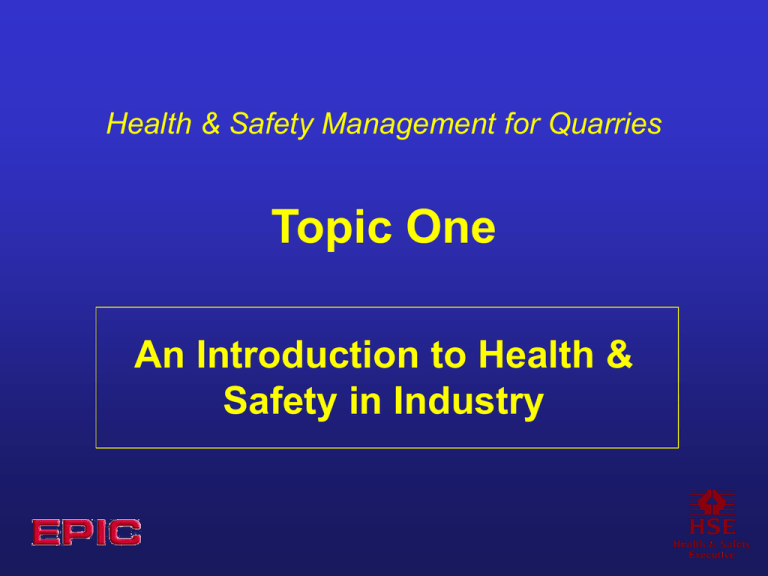
Health & Safety Management for Quarries Topic One An Introduction to Health & Safety in Industry Objectives of this Section To define the basic terminology of the subject area. To outline the reasons for a safe and healthy workplace. To show the accident trends in the UK industry as a whole and the quarrying industry in particular. Accident – Undesired circumstances which give rise to ill-health or injury, damage to property, plant, products or the environment; production losses or increased liabilities. Incident – Undesired circumstances and ‘near misses’ which could cause accidents. Ill health – Acute and chronic ill health caused by physical, chemical or biological agents as well as adverse effects on mental health. Hazard – The potential to cause harm. Harm including ill health and injury, damage to property, plant, products or the environment, production losses or increased liabilities. Risk Means the likelihood that a specified undesired event will occur due to the realisation of a hazard by, or during work activities or by the products and services created by work activities. Hazards/Danger Observable or predicted from knowledge Risk Not directly observable - probability of harm to system elements being realised from exposure to hazards and danger. Harm Damage to system elements - long or short term Injuries Accidents Ill-Health Damage Safety The ‘control of accidental loss’. Reasons for Preventing Accidents There are three main reasons for preventing accidents and ill-health. Moral / Humane No-one comes to work to be injured or killed Cost Accidents cost organisations money. e.g. Piper Alpha – 167 people killed – estimated to have cost over £2 billion including £746 million in direct insurance payouts. Legislation Organisations have a legal obligation. In the UK – Health & Safety at Work Act, 1974 and associated Regulations e.g. Management of Health & Safety at Work Regs 1999 Quarry Regulations, 1999 Accident Costs ‘Iceberg’ Insurance Costs £1 £8-36 Covering Injury, health, damage ill Uninsured Costs Product and material damage. Plant & building damage Tool & equipment damage. Legal costs Expenditure on emergency supplies. Clearing site Production delays Overtime working and temporary labour Investigation time. Supervisor’s time diverted Clerical effort. Fines Loss of expertise/experience Injuries in the UK (1989/90 – 1998/99) Fatal 1989/90 1990/91 1991/92 1992/93 1993/94 1994/95 1995/96 1996/97 (a) 1997/98 1998/99 681 (b) 572 473 452 403 376 344 654 667 625 Major Workers 21706 21222 18698 18053 17979 18354 17734 29320 30002 28821 Non-fatal Public 11378 9981 11009 10669 11552 12642 13234 35694 28613 23588 +3 day 167109 162888 154338 143283 137459 142218 132976 129568 135773 131191 TOTAL 220874 194663 184518 172457 167393 173590 164288 195236 195055 184225 Notes: (a) Figures from 1996/97 are higher than previous years because of changes in accident reporting brought about by RIDDOR’95 (Reporting of Injuries, Diseases and Dangerous Occurrences Regulation). Hence these figures cannot be compared with those of earlier years. (b) This figure includes the 95 persons killed in the Hillsborough Stadium Disaster. Comparison of Accident Rate (1997/98) Quarry Industry Construction All Industry Fatal 20 6 1 Major 400 382 128 +3 Day 1,400 966 589 Accidents in the Quarrying Industry (1994-99) 250 200 193 150 100 144 115 108 5 8 124 50 3 8 5 0 1994/95 1995/96 1996/97 1997/98 1998/99 Fatal Major Types of Fatal Accident (1983-1993) Conveyors OHL Falling Objects Vehicles SFS Crusher Blockages Other Maintainence Types of Fatal Accidents (1983-93) OHL (3%) Maintenance (5%) Contact with Overhead Electricity Lines While maintaining plant or equipment Other (11%) Crusher Blockages (4%) Other accidents involving machinery, asphyxiation, burns or explosions While clearing crusher or feeder blockages Vehicles (41%) SFS (13%) Runover by a vehicle, vehicles running over open edge of quarry face, bench or ramp, trapped under vehicle body, vehicle overturned on quarry floor or road and vehicles colliding with plants or other vehicles Stumbling, Falling or Slipping Falling (8%) Struck by falling objects or ground Engulfed (4%) Conveyors (11%) Buried in material Trapped between belt and head/tail drum rollers

